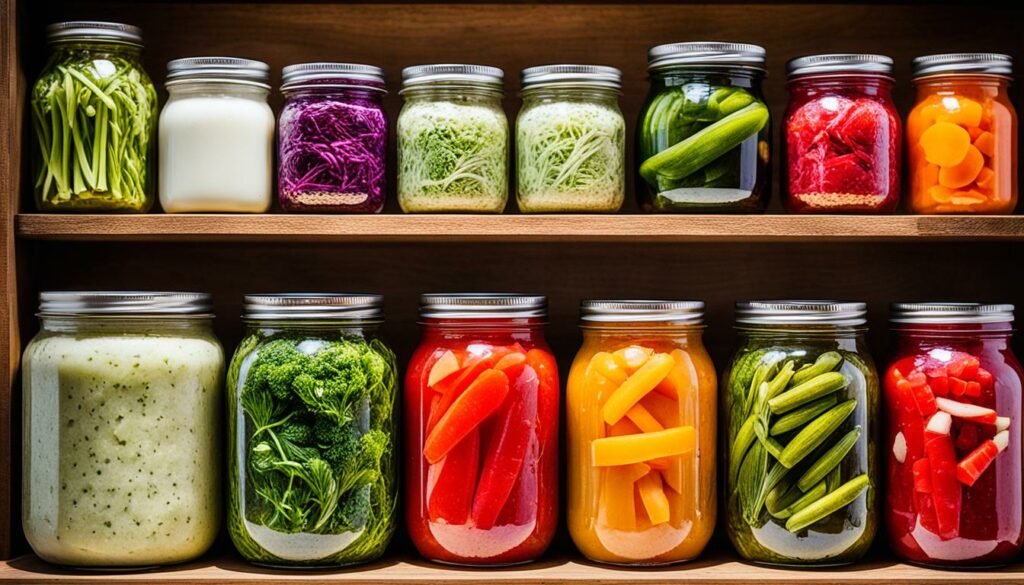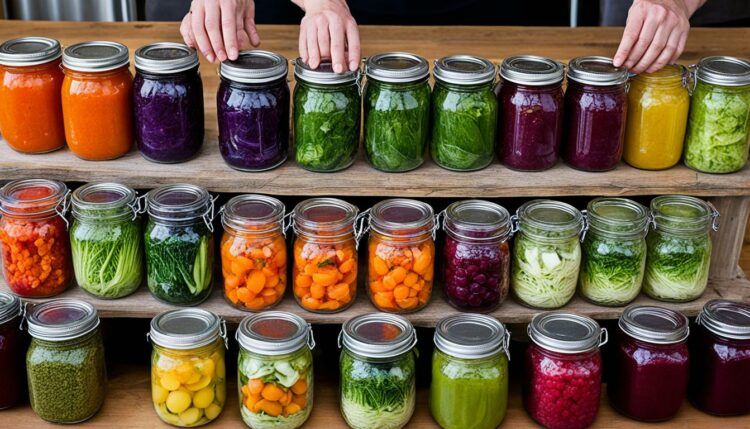Did you know that the average human has trillions of bacteria living in their gut? These microorganisms, collectively known as the microbiome, play a crucial role in our overall health and well-being.
One way to support a healthy gut and promote microbiome diversity is by incorporating fermented foods into our diet.
Key Takeaways:
- Fermented foods have been consumed for thousands of years and are known to promote a healthy gut.
- A diet high in fermented foods can have positive effects on the immune system and overall health.
- Fermentation is a process where microorganisms break down sugars in food, producing beneficial compounds.
- Types of fermented foods include yogurt, sauerkraut, kimchi, kombucha, and miso.
- Consuming fermented foods can support digestion, balance the gut microbiome, and improve immune function.
The Science Behind Fermented Foods
Fermentation is a natural process that has been used by humans for centuries to transform food. It involves the breakdown of sugars in food by microorganisms such as bacteria and yeast, which produce lactic acid and other beneficial compounds in the process.
This fermentation process not only preserves the food but also enhances its flavor and nutrition.
When fermented foods are consumed, they introduce a diverse range of beneficial bacteria to the gut, promoting microbiome diversity.
The gut microbiome is a complex community of microorganisms that plays a crucial role in digestion, nutrient absorption, and immune function. By consuming fermented foods, you can support the growth of beneficial bacteria in your gut, which contributes to a healthy microbiome.
The interaction between the bacteria introduced by fermented foods and the immune system is an exciting area of research. Studies have shown that these bacteria can stimulate the immune system, leading to improved immune responses.
This may help the body defend against harmful pathogens and reduce the risk of certain immune-related disorders.
Research has indicated that the consumption of fermented foods can positively influence the gut microbiome and immune responses. This highlights the potential of fermented foods as a natural strategy to enhance overall health and well-being.
Source: McGovern et al., 2004; Stanford researchers, 2021; Tamang et al., 2020
| Fermentation Process | Microbiome Diversity | Immune Responses |
|---|---|---|
| Fermentation is the breakdown of sugars in food by microorganisms, resulting in the production of lactic acid and other compounds. | Consuming fermented foods introduces a diverse range of beneficial bacteria to the gut, promoting microbiome diversity. | The beneficial bacteria from fermented foods can interact with the immune system, leading to improved immune responses. |
| Fermentation preserves the food and enhances its flavor and nutritional value. | A diverse microbiome is associated with better overall health and a reduced risk of certain diseases. | Improved immune responses may help protect against harmful pathogens and reduce the risk of immune-related disorders. |
Types of Fermented Foods
Fermented foods have a rich diversity of flavors and origins. They are enjoyed by cultures all over the world for their unique tastes and health benefits. Incorporating a variety of fermented foods into your diet can provide an exciting culinary experience while supporting your gut health.
Here are some common types of fermented foods:
- Yogurt: Made by fermenting milk with live cultures, yogurt is a creamy and tangy food that is packed with probiotics.
- Kefir: Similar to yogurt, kefir is a fermented milk drink that has a thin consistency and a slightly sour taste.
- Sauerkraut: This fermented cabbage dish is a staple in many European cuisines, known for its tangy and crunchy texture.
- Kimchi: A popular Korean side dish, kimchi is made from fermented vegetables, primarily cabbage, with a spicy and pungent flavor.
- Kombucha: Kombucha is a fermented tea drink that is known for its fizzy texture, tangy taste, and potential health benefits.
- Miso: A traditional Japanese seasoning made from fermented soybeans, miso adds a rich umami flavor to soups, marinades, and dressings.
Other fermented foods include sourdough bread, pickles, tempeh, and certain cheeses. Each of these foods undergoes the fermentation process, resulting in the growth of beneficial bacteria and distinct flavors.
It’s important to note that while these are examples of common fermented foods, the world of fermentation is vast and encompasses a wide array of dishes from different cultures.

Health Benefits of Fermented Foods
Consuming fermented foods offers a plethora of benefits for your overall health and well-being. These foods, rich in beneficial bacteria, actively contribute to a healthy gut, promote efficient digestion, and enhance nutrient absorption.
One major advantage of including fermented foods in your diet is their ability to balance the gut microbiome. The introduction of diverse strains of beneficial bacteria helps in reducing the risk of inflammatory conditions and digestive disorders.
Fermented foods can also have a positive impact on your immune system. The presence of beneficial bacteria stimulates the immune response, improving its function and enhancing the body’s ability to fight off infections and diseases.
In addition to digestive and immune benefits, fermented foods may also support weight management. Some studies suggest that the consumption of fermented foods could help regulate appetite, reduce cravings, and improve satiety, aiding in weight control.
Overall, fermented foods play a crucial role in maintaining gut health and supporting various physiological functions. Incorporating a variety of these foods into your diet can contribute to a balanced microbiome, improved digestion, and enhanced overall well-being.
References:
- Chilton, S. N., Burton, J. P., & Reid, G. (2015). Inclusion of fermented foods in food guides around the world. Nutrients, 7(1), 390-404.
- Tamang, J. P., Shin, D. H., Jung, S. J., & Chae, S. W. (2020). Functional properties of microorganisms in fermented foods. Frontiers in Microbiology, 11, 1-21.
- National Institutes of Health. (2021). Gut Health and the Microbiome. Retrieved from [insert URL]
Making Fermented Foods at Home
Making fermented foods at home is a rewarding and cost-effective way to incorporate them into your diet. By following simple recipes and techniques, you can create delicious and nutritious fermented foods right in your own kitchen. Here’s a step-by-step guide on how to make your own fermented foods:
1. Choose Your Ingredients
Start by selecting high-quality ingredients for your fermented foods. You can use a variety of vegetables, spices, or dairy products depending on the recipe you’re following. Fresh and organic ingredients are recommended for the best taste and nutritional value.
2. Prepare Your Starter Culture or Naturally Occurring Microorganisms
To kickstart the fermentation process, you’ll need a starter culture or naturally occurring microorganisms. Starter cultures are easily available in stores and online, or you can use naturally occurring bacteria from fresh vegetables or the atmosphere.
3. Combine Ingredients and Starter Culture
Mix your chosen ingredients with the starter culture or naturally occurring microorganisms. This combination will create the ideal environment for fermentation to occur. Ensure that the ingredients are evenly distributed for the fermentation process to proceed uniformly.
4. Fermentation and Temperature Control
Place the mixture in a clean, airtight container and allow it to ferment at the right temperature. The fermentation time can vary depending on the recipe, ranging from a few days to several weeks. Keep the container in a cool, dark place, away from direct sunlight and extreme temperature fluctuations.
5. Monitor and Taste Test
During the fermentation process, it’s essential to monitor the progress of your fermented foods. Taste tests can help you determine the desired level of fermentation and flavor development. If needed, adjust the fermentation time or other factors to achieve the desired taste and texture.
6. Storage and Enjoyment
Once the fermentation process is complete, transfer your fermented foods to the refrigerator for long-term storage. Fermented foods can be enjoyed as a standalone dish, added to meals, or used as condiments to enhance flavors. Experiment with different combinations and recipes to find your favorites.

Whether you’re making sauerkraut, kimchi, kefir, or any other fermented foods, the process of making them at home allows you to customize the taste and ingredients according to your preferences. Enjoy the health benefits and flavors of homemade fermented foods!
Tips for Incorporating Fermented Foods into Your Diet
If you’re new to fermented foods, there are several ways you can incorporate them into your daily diet. Start by adding a small serving of fermented foods to a meal or snack. For example, you can top your salads or sandwiches with sauerkraut or kimchi, or enjoy a serving of yogurt or kefir as a snack or breakfast.
Experiment with different flavors and textures to find what you enjoy the most. Gradually increase the portion sizes and variety of fermented foods to maximize their benefits for your gut health and microbiome.
Here are a few tips to help you incorporate fermented foods:
- Start with small servings: Begin by adding a small amount of fermented foods to your meals or snacks, allowing your palate to adjust to the flavors.
- Pair them with other foods: Combine fermented foods with other ingredients to enhance the taste and nutritional value of your meals. For example, you can mix fermented vegetables with fresh greens in a salad.
- Try different variations: Explore various fermented foods to find the ones that suit your preferences. Experiment with different flavors, such as spicy kimchi or tangy kombucha.
- Incorporate them into your existing recipes: Add fermented foods to your favorite dishes, such as stir-fries, soups, or grain bowls, to add a unique twist and boost their nutritional content.
- Make homemade versions: Consider making your own fermented foods at home using starter cultures or natural fermentation methods. This allows you to customize the ingredients and flavors according to your taste.
- Gradually increase portion sizes: As your taste buds adapt to the flavors of fermented foods, gradually increase the serving sizes to fully experience their benefits for gut health and microbiome diversity.
Remember, incorporating fermented foods into your diet is a journey of exploration and experimentation. Enjoy the process of discovering new flavors and reaping the benefits of a healthy gut supported by these nourishing foods.
| Fermented Food | Description | Benefits |
|---|---|---|
| Yogurt | A dairy product made by fermenting milk with bacterial cultures. | Good source of probiotics, calcium, and protein. |
| Sauerkraut | Fermented cabbage with a tangy flavor and crisp texture. | Rich in vitamins C and K, fiber, and beneficial bacteria. |
| Kimchi | A spicy Korean side dish made from fermented vegetables, primarily cabbage. | Packed with vitamins, minerals, and probiotics that support digestion. |
| Kefir | A fermented milk drink with a tangy taste and creamy texture. | Contains probiotics, vitamins, minerals, and easily digestible proteins. |
| Kombucha | A fizzy, fermented tea known for its tart and slightly sweet flavor. | Offers probiotics, antioxidants, and potential digestive benefits. |
Conclusion
Incorporating fermented foods into your diet is a simple and delicious way to nurture a healthy gut and support microbiome diversity. The introduction of beneficial bacteria through fermented foods can have a positive impact on digestion, immunity, and overall well-being.
Whether you choose to make your own fermented foods at home or explore the wide array of commercially available options, prioritizing the inclusion of fermented foods in your diet is a wise choice for your health.
The diverse range of fermented foods, such as yogurt, sauerkraut, kimchi, and miso, provides an excellent opportunity to experiment with flavors and enjoy the numerous health benefits they offer.
Take a proactive approach to supporting your gut health by gradually increasing the portion sizes and variety of fermented foods in your meals. By doing so, you can nourish your microbiome, enhance your digestive processes, and reap the rewards of a healthy gut.
Embrace the power of fermented foods and give your microbiome the support it needs for optimal well-being.
FAQ
What are fermented foods?
Fermented foods are food products that have undergone a process called fermentation, in which microorganisms like bacteria and yeast break down sugars in the food, producing lactic acid and other compounds. This process not only preserves the food but also enhances its flavor and nutritional value.
What are the benefits of fermented foods?
Consuming fermented foods can have several positive effects on health. These foods introduce beneficial bacteria to the gut, promote a healthy gut by supporting digestion and nutrient absorption, and help balance the gut microbiome. They may also improve immune function, support weight management, and contribute to overall well-being.
What are some common types of fermented foods?
Some common types of fermented foods include yogurt, kefir, sauerkraut, kimchi, kombucha, miso, sourdough bread, pickles, tempeh, and certain cheeses. Each of these foods undergoes the fermentation process, leading to the growth of beneficial bacteria and the development of unique flavors.
How can I make fermented foods at home?
Making fermented foods at home can be a rewarding and cost-effective way to incorporate them into your diet. The process typically involves combining the desired ingredients with a starter culture or naturally occurring microorganisms and allowing the mixture to ferment at the right temperature for a certain period.
There are numerous recipes available with step-by-step instructions and variations to suit different tastes.
How can I incorporate fermented foods into my diet?
If you’re new to fermented foods, you can start by adding a small serving to a meal or snack. For example, you can top salads or sandwiches with sauerkraut or kimchi, or enjoy yogurt or kefir as a snack or breakfast. Gradually increase portion sizes and variety to maximize the benefits for your gut health and microbiome.
What is the science behind fermented foods?
Fermented foods introduce beneficial bacteria to the gut, promoting a diverse and healthy microbiome. These bacteria can interact with the immune system, leading to improved immune responses. Research has shown that a diet high in fermented foods can have positive effects on the immune system and overall health.
Why is a healthy gut important?
A healthy gut is important for overall well-being. It plays a crucial role in digestion, nutrient absorption, and immune function. A diverse microbiome, which can be supported by consuming fermented foods, is associated with better gut health and a reduced risk of inflammatory conditions and digestive disorders.




